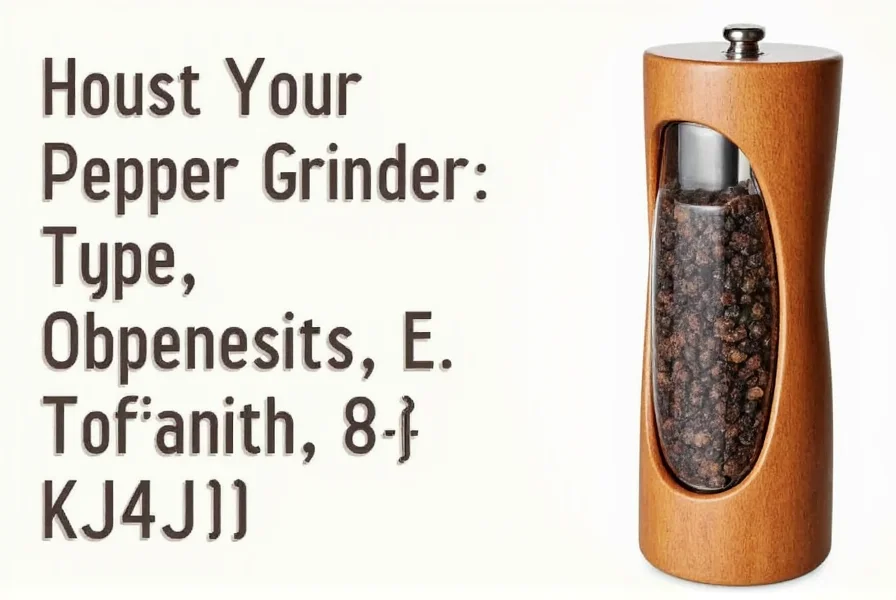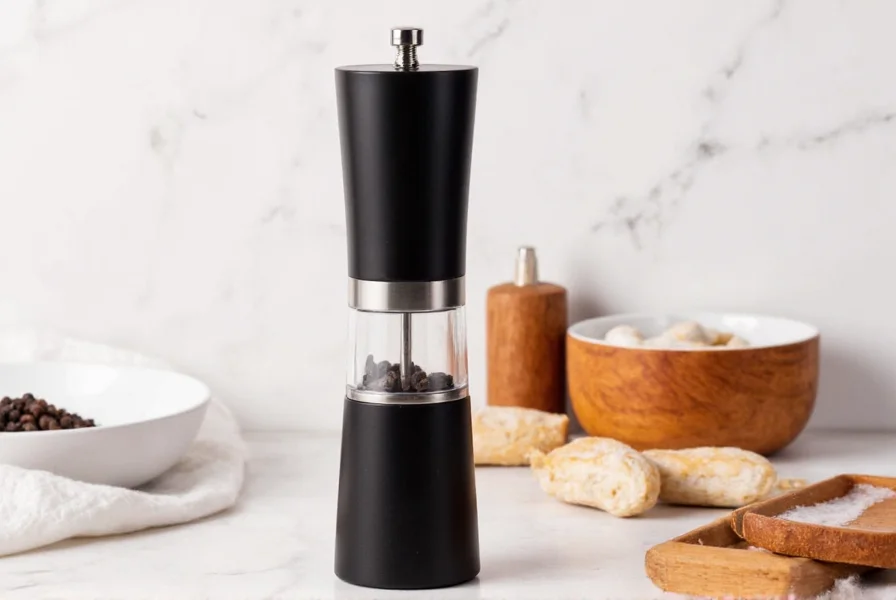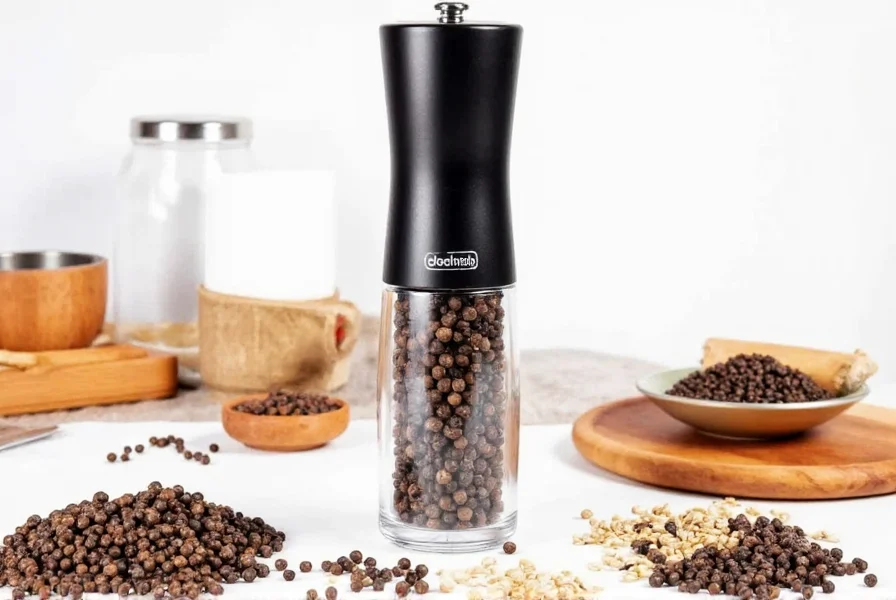Choosing the right black pepper grinder significantly impacts your culinary experience. Unlike pre-ground pepper that loses potency within weeks, freshly ground pepper delivers superior flavor and aroma. This comprehensive guide examines the critical factors that distinguish exceptional pepper grinders from disappointing models, helping you make an informed decision based on your specific kitchen needs.
Understanding Pepper Grinder Types
Pepper grinders fall into two primary categories: manual and electric. Manual models require physical operation but offer greater control over grind consistency. Electric models provide convenience but may lack the precision of manual operation. Within these categories, the grinding mechanism represents the most crucial differentiating factor.
Grinding Mechanism: The Heart of Your Grinder
The grinding mechanism determines performance, durability, and versatility. Three primary mechanisms dominate the market:
| Mechanism Type | Best For | Lifespan | Key Advantage |
|---|---|---|---|
| Stainless Steel | Daily home use | 3-5 years | Durable, handles both pepper and salt |
| Ceramic | Precision grinding | 5-10+ years | Corrosion-proof, maintains sharpness |
| Carbon Steel | Professional kitchens | 2-4 years | Exceptional sharpness (requires maintenance) |
Ceramic mechanisms represent the premium option for serious home cooks. Unlike metal counterparts, ceramic won't corrode when grinding salt, maintains sharpness longer, and doesn't transfer metallic flavors to your spices. Stainless steel mechanisms offer excellent value and versatility for general kitchen use. Carbon steel provides professional-grade performance but requires careful maintenance to prevent rust.

Material Considerations for Pepper Grinder Construction
The body material affects both aesthetics and functionality. Common options include:
- Solid Wood: Provides natural insulation against temperature changes, preventing condensation inside the grinder. Look for sustainably sourced hardwoods like beech or walnut that resist moisture absorption.
- Stainless Steel: Offers durability and modern aesthetics. Ensure it's 18/10 grade for optimal corrosion resistance, especially important if you plan to use the grinder for salt as well.
- Acrylic: Budget-friendly but often shows wear quickly. Higher quality acrylic models incorporate UV protection to prevent yellowing over time.
When evaluating electric vs manual pepper grinder options, consider that manual models typically provide better control over grind size and tend to last longer with proper maintenance. Electric models excel in accessibility situations but often sacrifice precision for convenience.
Adjustability: Why It Matters
The ability to adjust grind coarseness represents a critical feature often overlooked by beginners. Professional chefs recognize that different dishes require specific grind sizes:
- Coarse grind: Ideal for steak rubs and pickling (larger particles release flavor slowly)
- Medium grind: Perfect for most cooking applications and table use
- Fine grind: Best for marinades and spice blends where even distribution matters
Look for grinders with smooth, precise adjustment mechanisms that maintain settings during use. The best pepper grinder for home kitchen use features clear markings and responsive adjustment without requiring excessive force.
Maintenance Requirements by Mechanism Type
Proper care extends your grinder's lifespan significantly. Different mechanisms require specific maintenance approaches:
- Ceramic mechanisms: Never require oiling. Clean by grinding uncooked rice through the mechanism periodically to remove residue.
- Stainless steel: Wipe exterior with damp cloth. Avoid submerging in water which can damage internal components.
- Carbon steel: Requires occasional light oiling after thorough drying to prevent rust formation.
Understanding pepper grinder maintenance tips helps prevent common issues like clogging and inconsistent grinding. Never store your grinder with peppercorns inside for extended periods, as moisture from the spices can cause corrosion in metal mechanisms.

Common Misconceptions About Pepper Grinders
Several myths persist in the culinary community that affect purchasing decisions:
- "All grinders work equally well for salt and pepper": Only ceramic or high-grade stainless steel mechanisms handle salt without corrosion.
- "Price correlates directly with quality": Many mid-range models outperform expensive designer options in durability testing.
- "Larger grinders are always better": Smaller capacity grinders preserve peppercorn freshness longer by reducing air exposure.
Making Your Selection: Practical Recommendations
When determining how to choose a pepper grinder, consider your specific usage patterns:
- For occasional home use: A compact ceramic mechanism grinder with wood body offers excellent value and performance.
- For frequent cooking: Invest in a larger capacity stainless steel model with precise adjustment.
- For professional results: Consider a dedicated pepper grinder alongside a separate salt grinder with ceramic mechanism.
The ideal black pepper grinder balances performance, durability, and usability for your specific kitchen workflow. Remember that even the best manual black pepper grinder requires proper care to maintain optimal performance over time.
Frequently Asked Questions
Can I use the same grinder for both salt and pepper?
No, using the same grinder for salt and pepper causes cross-contamination of flavors and accelerates corrosion in metal mechanisms. Salt's hygroscopic nature draws moisture that corrodes metal components. Always use separate grinders—one with a ceramic mechanism for salt, and either ceramic or stainless steel for pepper.
How often should I replace my pepper grinder?
A quality pepper grinder with a ceramic mechanism can last 10+ years with proper care. Stainless steel mechanisms typically last 3-5 years before showing performance degradation. Replace your grinder when you notice inconsistent grinding, difficulty adjusting coarseness, or visible corrosion in metal components. Regular maintenance significantly extends lifespan.
Why does my pepper grinder stop working properly?
Most pepper grinder malfunctions stem from moisture exposure, improper storage with peppercorns inside for extended periods, or using low-quality peppercorns with high moisture content. Ceramic mechanisms rarely fail mechanically but can clog with residue. Metal mechanisms corrode when exposed to humidity or used for salt. Regular cleaning with uncooked rice through the mechanism prevents most issues.
What's the difference between pepper mill and pepper grinder?
The terms are often used interchangeably, but traditionally "pepper mill" refers to larger countertop models, while "pepper grinder" describes smaller handheld versions. Functionally, both perform the same task. The key difference lies in capacity and intended use—mills typically hold more peppercorns and feature sturdier construction for frequent use.











 浙公网安备
33010002000092号
浙公网安备
33010002000092号 浙B2-20120091-4
浙B2-20120091-4